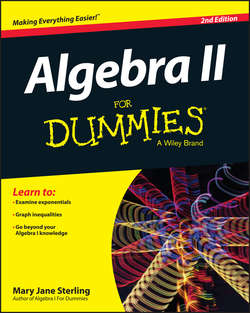Читать книгу Algebra II For Dummies - Sterling Mary Jane - Страница 5
На сайте Литреса книга снята с продажи.
Part I
Homing in on Basic Solutions
Chapter 1
Going Beyond Beginning Algebra
Outlining Algebraic Properties
ОглавлениеMathematicians developed the rules and properties you use in algebra so that every student, researcher, curious scholar, and bored geek working on the same problem would get the same answer – no matter the time or place. You don’t want the rules changing on you every day (and I don’t want to have to write a new book every year!); you want consistency and security, which you get from the strong algebra rules and properties that I present in this section.
Keeping order with the commutative property
The commutative property applies to the operations of addition and multiplication. It states that you can change the order of the values in a particular operation without changing the final result:
If you add 2 and 3, you get 5. If you add 3 and 2, you still get 5. If you multiply 2 times 3, you get 6. If you multiply 3 times 2, you still get 6.
Algebraic expressions usually appear in a particular order, which comes in handy when you have to deal with variables and coefficients (multipliers of variables). The number part comes first, followed by the letters, in alphabetical order. But the beauty of the commutative property is that 2xyz is the same as x2zy. You have no good reason to write the expression in that second, jumbled order, but it’s helpful to know that you can change the order around when you need to.
Maintaining group harmony with the associative property
Like the commutative property (see the previous section), the associative property applies only to the operations of addition and multiplication. The associative property states that you can change the grouping of operations without changing the result:
You can use the associative property of addition or multiplication to your advantage when simplifying expressions. And if you throw in the commutative property when necessary, you have a powerful combination. For instance, when simplifying (x + 14) + (3x + 6), you can start by dropping the parentheses (thanks to the associative property). You then switch the middle two terms around, using the commutative property of addition. You finish by reassociating the terms with parentheses and combining the like terms:
The steps in the previous process involve a lot more detail than you really need. You probably did the problem, as I first stated it, in your head. I provide the steps to illustrate how the commutative and associative properties work together; now you can apply them to more complex situations.
Distributing a wealth of values
The distributive property states that you can multiply each term in an expression within parentheses by the multiplier outside the parentheses and not change the value of the expression. It takes one operation, multiplication, and spreads it out over terms that you add to and subtract from one another:
For instance, you can use the distributive property on the problem
to make your life easier. You distribute the 12 over the fractions by multiplying each fraction by 12 and then combining the results:
Finding the answer with the distributive property is much easier than changing all the fractions to equivalent fractions with common denominators of 12, combining them, and then multiplying by 12.
You can use the distributive property to simplify equations – in other words, you can prepare them to be solved. You also do the opposite of the distributive property when you factor expressions; see the section “Implementing Factoring Techniques” later in this chapter.
Checking out an algebraic ID
The numbers zero and one have special roles in algebra – as identities. You use identities in algebra when solving equations and simplifying expressions. You need to keep an expression equal to the same value, but you want to change its format, so you use an identity in one way or another:
Applying the additive identity
One situation that calls for the use of the additive identity is when you want to change the format of an expression so you can factor it. For instance, take the expression x2 + 6x and add 0 to it. You get x2 + 6x + 0, which doesn’t do much for you (or me, for that matter). But how about replacing that 0 with both 9 and –9? You now have x2 + 6x + 9 – 9, which you can write as (x2 + 6x + 9) – 9 and factor into (x + 3)2 – 9. Why in the world do you want to do this? Go to Chapter 11 and read up on conic sections to see why. By both adding and subtracting 9, you add 0 – the additive identity.
Making multiple identity decisions
You use the multiplicative identity extensively when you work with fractions. Whenever you rewrite fractions with a common denominator, you actually multiply by one. If you want the fraction to have a denominator of 6x, for example, you multiply both the numerator and denominator by 3:
Now you’re ready to rock and roll with a fraction to your liking.
Singing along in-verses
You face two types of inverses in algebra: additive inverses and multiplicative inverses. The additive inverse matches up with the additive identity and the multiplicative inverse matches up with the multiplicative identity. The additive inverse is connected to zero, and the multiplicative inverse is connected to one.
A number and its additive inverse add up to zero. A number and its multiplicative inverse have a product of one. For example, –3 and 3 are additive inverses; the multiplicative inverse of –3 is . Inverses come into play big-time when you’re solving equations and want to isolate the variable. You use inverses by adding them to get zero next to the variable or by multiplying them to get one as a multiplier (or coefficient) of the variable.
